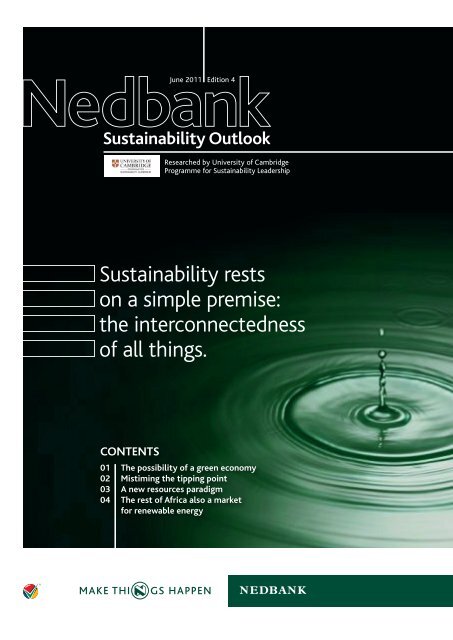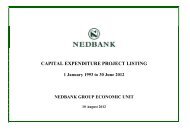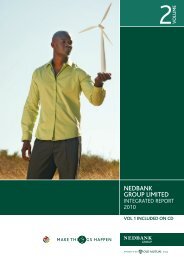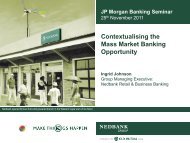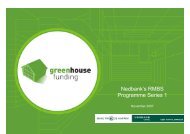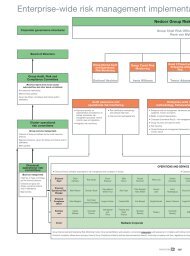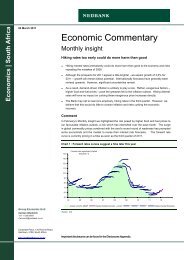To read more download PDF - Nedbank Group Limited
To read more download PDF - Nedbank Group Limited
To read more download PDF - Nedbank Group Limited
You also want an ePaper? Increase the reach of your titles
YUMPU automatically turns print PDFs into web optimized ePapers that Google loves.
June 2011 Edition 4<br />
Researched by University of Cambridge<br />
Programme for Sustainability Leadership<br />
Sustainability rests<br />
on a simple premise:<br />
the interconnectedness<br />
of all things.<br />
CONTENTS<br />
01 The possibility of a green economy<br />
02 Mistiming the tipping point<br />
03 A new resources paradigm<br />
04 The rest of Africa also a market<br />
for renewable energy
THE POSSIBILITY OF<br />
A GREEN ECONOMY<br />
German statesman, Otto von Bismarck, famously remarked<br />
that ‘politics is the art of the possible’. For a long time proposals<br />
for <strong>more</strong> sustainable development actions did not succeed in<br />
the political arena, as there was little confidence that these<br />
would be technically, economically and socially possible.<br />
Pointing out that unsustainable development is inherently<br />
unsustainable has not been enough. More and <strong>more</strong> studies<br />
are, however, now emerging showing that sustainable economic<br />
development is technically possible, economically affordable in<br />
the short term and superior in the long term and has significant<br />
social benefits. The most important of the recent publications<br />
is <strong>To</strong>wards a Green Economy, i published by the United Nations<br />
Environment Programme (UNEP) under the project leadership of<br />
Deutsche Bank investment banker, Pavan Sukhdev.<br />
% 4,0<br />
3,5<br />
3,0<br />
2,5<br />
2,0<br />
1,5<br />
1,0<br />
0,5<br />
Figure 1: Projected trends in annual GDP growth | Source: UNEP Green Economy report<br />
0,0<br />
2010<br />
2015 2020 2025 2030 2035 2040 2045 2050<br />
Green investment scenario<br />
Business-as-usual scenario<br />
The report compared, by means of a macroeconomic model,<br />
the impacts of investments in greening the economy with<br />
investments in a business-as-usual (BAU) scenario. The results<br />
were measured not only in terms of traditional GDP, but also in<br />
terms of impacts on employment, resource intensity, emissions,<br />
and ecological impact. Overall the goal of the green economy<br />
scenario was to address persistent poverty and achieve the<br />
reduction of greenhouse gas (GHG) emissions, so that the<br />
atmospheric concentration will remain under 450 parts per<br />
million by 2050, a level essential for having a reasonable<br />
likelihood of limiting global warming to the threshold of 2˚C.<br />
The report concluded that an investment of about 2% of global<br />
GDP (currently US$1,3 trillion) per annum into ten broad areas<br />
can lead to GDP being 15,7% higher in 2050 than it would be in<br />
the BAU scenario. The green investments path will lead to faster<br />
economic growth within as little as six years. This is calculated<br />
by modelling the impact of the increasing scarcity of energy<br />
and natural resources, but without taking into account the<br />
potential negative impacts of climate change or a major loss of<br />
ecosystems. While the investment requirement of 2% of GDP<br />
per annum is a big number, it should be seen relative to gross<br />
capital formation, which stood at 22% of GDP in 2009.<br />
A quarter (US$325 billion) of the green investments is allocated<br />
to natural capital sectors: forestry, agriculture, fresh water<br />
and fisheries. Some of the specific measures proposed include<br />
paying forest land holders to conserve forests and investing in<br />
reforestation – annual investments of about US$15 billion that<br />
could raise the value added by the forestry industry by <strong>more</strong> than<br />
20% compared with BAU. Annual investment of US$108 billion<br />
in green agriculture to shift to the efficient use of water, extensive<br />
use of organic and natural soil nutrients, optimal tillage and<br />
integrated pest control would lead over time to enhanced soil<br />
quality and an increase in crop yields of 10% above what is<br />
possible with current investment strategies. The investments<br />
in natural capital have a particular benefit for the poor, who<br />
currently rely on subsistence farming or lack access to fresh<br />
water and enough food. It also leads to a 21,6% decrease in total<br />
water demand, a 21% increase in total forest land and a 47,9%<br />
decrease in the ecological footprint-to-biocapacity ratio by 2050,<br />
compared with BAU.<br />
Just over 15% of the targeted investments is allocated to buildings<br />
and industry, mostly for energy efficiency. Investments in transport<br />
require the second highest amount, US$194 billion per annum,<br />
and include increased energy efficiency, using clean fuels, and<br />
modal shifts towards public and non-motorised transport.<br />
The area requiring the greatest investment is energy supply –<br />
US$362 billion per annum. This will allow the penetration rate<br />
of renewables in power generation to increase to 45% by 2050.<br />
An important feature of the Green Economy report is the value<br />
of an integrated approach as opposed to single interventions in<br />
energy, for example. The investment in agriculture and forestry<br />
improves those systems’ ability to absorb carbon, and thus<br />
lowers net emissions. Similarly, increasing urban density not<br />
only reduces the total energy demand from mobility, but can<br />
also, according to other studies, raise labour productivity and<br />
lower the cost of infrastructural development. i i<br />
01 | <strong>Nedbank</strong> Sustainability Outlook
Financing the transition<br />
An important question arising from a report such as this is:<br />
how will the transition be financed Fortunately not all of the<br />
US$1,3 trillion is made up of additional investments – some<br />
of it merely requires a rechanneling of existing investments<br />
and expenditure. A first important source could therefore be<br />
reforming harmful subsidies. Fossil fuels consumption subsidies<br />
globally are about US$557 billion per annum and production<br />
subsidies another US$100 billion. Some subsidies such as<br />
South Africa’s favourable electricity pricing agreements with the<br />
aluminium and zinc industries, recently valued at about R6,5 billion, i i i<br />
are tied up in long-term contracts and cannot be cancelled, but can<br />
possibly be renegotiated. About US$19,2 billion of the subsidies<br />
to the global fishing industry is contributing to the industry’s<br />
contraction, so this could be reoriented to strengthen fisheries<br />
management and financing a reduction of excess capacity.<br />
A second potential element of funding the greening of the<br />
economy is fiscal instruments such as various types of ecotaxes.<br />
This could include carbon taxes, road congestion charges,<br />
higher tariffs for waste, and royalties on mineral and petroleum<br />
extraction. Many of these taxes can be complemented by<br />
measures to decrease the impact on the poor or on private<br />
sector investments. Another potential source of public funding is<br />
fiscal stimuli similar to those put in place in response to the recent<br />
financial and economic crisis. Out of the estimated US$3,3 trillion<br />
in stimulus funds, almost 16%, or US$522 billion, was initially<br />
allocated to green investments. The Chinese government’s 12th<br />
five-year plan period, starting in 2011, indicates that they will<br />
increase investment in green sectors to US$468 billion compared<br />
to US$211 billion over the last five years, with a focus on waste<br />
recycling and reutilisation, clean technologies and renewable<br />
energy (RE). Certain countries’ ability to use fiscal stimulus is,<br />
however, constrained by large deficits and the potentially negative<br />
consequences of the first round of fiscal stimuli is not yet clear.<br />
But, what is clear is that some new thinking is required to enable<br />
the financing of a green economy. Especially in terms of ways that<br />
public funds can be used to leverage the pools of private capital.<br />
The funds in the financial services sector can play a major<br />
role in funding the transition to a green economy if certain<br />
institutional barriers can be overcome. Insurers could play a<br />
pioneering role given the strong case that a green economy<br />
lowers risks from social instability, crop failures, extreme weather<br />
events and health risks. A risk-mitigation case can also be built<br />
for commercial banks that often finance property and plant for<br />
between 20 and 30 years. Long-term investors, such as pension<br />
funds, some mutual funds and sovereign wealth funds, are also<br />
important potential sources of funding. The green investment<br />
scenario’s lower GDP growth over the first five years is cancelled<br />
by the subsequent higher growth, and the cumulative effect<br />
becomes positive after just <strong>more</strong> than 10 years.<br />
One can thus, for example, see the development of structured<br />
products that discount increased future cashflows to enable<br />
longer term investments.<br />
Figure 2: Global assets in 2009 | Source: TheCityUK, Fund Management 2010<br />
45<br />
40<br />
35<br />
30<br />
25<br />
20<br />
15<br />
10<br />
5<br />
0<br />
28<br />
Pension funds<br />
22,9<br />
Mutual funds<br />
Growing green<br />
20,4<br />
Insurance funds<br />
in trillions of US$<br />
3,8 2,5 1,7 1<br />
SWFs<br />
The UNEP <strong>To</strong>wards a Green Economy report, above all, disproves<br />
the notion that there is a necessary tradeoff between environmental<br />
sustainability and economic progress. It makes it clear<br />
that green investments can reduce persistent poverty and, over<br />
the long term, lead to greater job creation, while at the same<br />
time giving future generations the opportunity to prosper.<br />
Creating a green economy is economically and technically<br />
possible and should, accordingly, be compatible with the political<br />
goals of ensuring a better life for all.<br />
MISTIMING THE TIPPING POINT<br />
Charles Prince, the former CE of Citigroup, infamously remarked<br />
in July 2007, ‘As long as the music is playing, you’ve got to get<br />
up and dance’. This was only four months before he was asked<br />
to step down in response to the US$11 billion writedowns that<br />
his company had to make after the credit party came to an<br />
end. After the fact it is easy to laugh at Prince’s statement, but<br />
the reality is that, despite several people warning of a housing<br />
or credit bubble, few had the discipline to sit out the dance.<br />
As John Maynard Keynes once quipped, ‘A sound banker, alas,<br />
is not one who foresees danger and avoids it, but one who,<br />
when he is ruined, is ruined in a conventional and orthodox<br />
Private equity<br />
way along with his fellows, so that no one can really blame him’. iv<br />
Hedge funds<br />
ETFs<br />
39<br />
Private wealth<br />
02 | <strong>Nedbank</strong> Sustainability Outlook
The financial crisis should, however, be a reminder that not<br />
leaving the dance floor soon enough, or not knowing when<br />
the tune changes, can have significant consequences.<br />
Malcolm Gladwell popularised the idea of ‘tipping points’ in<br />
his eponymous 2000 book. The thesis is that ideas, trends or<br />
social behaviours often mimic epidemics that start out slowly,<br />
but then suddenly cross a threshold and sp<strong>read</strong> like wildfire.<br />
After the tipping point the growth is not comparable with<br />
that experienced before. This goes against our intuition as<br />
Gladwell writes, ‘The idea of sudden change is at the centre of<br />
the idea of the Tipping Point and might well be the hardest of<br />
all to accept’. Besides that, it is very hard to predict if or when<br />
something will tip. It does not necessarily tip, for example, after<br />
a median is reached. Often it takes only a few actions to tip it,<br />
what Gladwell calls the ‘Law of the Few’.<br />
Harvard historian, Niall Ferguson, outlined a similar idea in his<br />
2010 article, Complexity and Collapse: Empires on the Edge of<br />
Chaos. v He asks, ‘What if history is not cyclical and slow moving<br />
but arhythmic – at times almost stationary, but also capable of<br />
accelerating suddenly, like a sports car What if collapse does<br />
not arrive over a number of centuries but comes suddenly, like<br />
a thief in the night’ His argument is based on the premise that<br />
political and economic structures are complex adaptive systems.<br />
The complexity theory describes how it takes only a small trigger<br />
to let a complex system ‘go critical’, triggering a phase transition<br />
from benign equilibrium to a crisis. Ferguson employs his theory<br />
to critique gradual-rise-and-decline explanations for the fall of<br />
empires, the causes of war and the financial crisis of 2007.<br />
‘Over the last three years, the complex system of the global<br />
economy flipped from boom to bust – all because a bunch of<br />
Americans started to default on their subprime mortgages,<br />
thereby blowing huge holes in the business models of<br />
thousands of highly leveraged financial institutions.’<br />
Referencing Jared Diamond’s book, Collapse, where the author<br />
warns of ecological collapse occurring because leaders have<br />
limited incentive to address problems that are unlikely to<br />
manifest themselves for decades, he compares this with<br />
climate change negotiations. Pleas to save the planet for future<br />
generations are insufficient to overcome economic distribution<br />
between rich and poor countries that exists in the here and now.<br />
Instead of debating the state of decline, what leaders and citizens<br />
should be worried about is a precipitous and unexpected fall.<br />
Similar to a highly leveraged financial system, the ecological<br />
system is currently being stretched beyond its carrying capacity.<br />
Climate scientists warn that our great concern should be<br />
climatic tipping points when positive feedback loops (with<br />
very negative consequences) are triggered. These include forest<br />
dieback in the Amazon and melting of the continental ice caps.<br />
Using a slightly different approach, a group of scientists vi has<br />
developed a planetary-boundaries framework to explore the<br />
safe operating space for humanity. When we transgress any of<br />
these boundaries, the system can ‘tip’ at any stage and go into<br />
a new, <strong>more</strong> undesirable state. According to their research, we<br />
have al<strong>read</strong>y transgressed the planetary boundary in three of<br />
the nine identified areas, namely climate change, nitrogen flow<br />
and biodiversity loss.<br />
Changing tack before it tips<br />
The prevailing sentiment seems to be that the change to a <strong>more</strong><br />
sustainable economy will happen gradually, maybe over decades,<br />
possibly only as a next generation <strong>more</strong> steeped in sustainability<br />
takes over decisionmaking. Following this line of thought, we<br />
can continue with investing activities as usual and gradually shift<br />
portfolios into <strong>more</strong> sustainability practices. It says that the music<br />
will still continue playing and one will lose too much by sitting<br />
it out or moving too early into something different, despite the<br />
market being built on unsustainable foundations.The possibility<br />
exists, however, that this paradigm could be wrong. Whether<br />
the system is tipped by an extreme environmental event or by<br />
enough people who suddenly realise that the short-termism<br />
of the investment community is undermining their long-term<br />
welfare, is impossible to forecast. But, for those investing in,<br />
for example, new mines or large fossil fuel energy systems this is a<br />
risk big enough to warrant much <strong>more</strong> serious consideration.<br />
A NEW RESOURCES PARADIGM<br />
When the chief executives of America’s largest oil companies<br />
were summoned to Washington in May this year to discuss<br />
the current high fuel prices, there was a certain irony to it.<br />
It was almost exactly 100 years after the breakup of Standard Oil,<br />
John D Rockefeller’s oil monopoly, deemed as profiting at the<br />
expense of the American people. Adding to the irony was the fact<br />
that the person taking the oil companies to task was Senator<br />
John D Rockefeller IV, great-grandson of the famous oil man.<br />
At issue was the US$2 billion in tax breaks that the companies<br />
receive every year.<br />
Whether the tax breaks are repealed or not would probably<br />
make little difference to the overall profits of the oil companies<br />
as a tight demand-supply relationship is keeping prices high.<br />
03 | <strong>Nedbank</strong> Sustainability Outlook
One of the proposals currently touted in the United States to<br />
increase local oil supply is to open the Arctic Wildlife National<br />
Reserve for drilling. But, according to the US Energy Information<br />
Administration, that would add only between 0,4 and 1,2 percent<br />
of total world oil consumption by 2030. That could decrease<br />
oil prices by about one dollar, assuming the Organisation of<br />
Petroleum Exporting Countries (OPEC) did nothing. vii<br />
upheaval in the rest of the Middle East. Of course, as many<br />
governments have learned, it is not very easy to cut social<br />
expenditure once these measures are in place. So, with Saudi<br />
Arabia’s ability to influence the price of oil through supply, it<br />
is hard to see how the Saudi Arabians would be keen for an<br />
average price that is much lower going forward, despite the<br />
obvious potential for short-term price volatility.<br />
Jeremy Grantham, the cofounder of the US$100 billion<br />
investment management firm, GMO, wrote in his April 2011<br />
newsletter vii i that he believed a paradigm shift might have<br />
occurred with commodities in 2002. Grantham does not make<br />
these claims lightly. He has built his very successful investment<br />
career around the belief in ‘reversion to the mean’ – the idea<br />
that prices revert to their long-term trend over time. In his<br />
January 2011 letter ix he still made fun of efficient market<br />
disciples who view all extreme over- or undervaluations as<br />
a paradigm shift, when in fact it is a bubble.<br />
But he believes the statistical probability of the current prices<br />
being a bubble is so slim that it is <strong>more</strong> likely that it is indeed<br />
a new paradigm. He calculated that over the 102 years from<br />
1900 to 2002, the price of commodities (measured as an equally<br />
weighted basket of 33 commodities) declined by 70% in real<br />
terms. That is an average decline of 1,2% per annum after<br />
inflation. But, since 2002, that entire decline was erased by a<br />
bigger price surge than occurred during World War II. The GMO<br />
team has studied 330 completed asset bubbles, which they<br />
define as prices <strong>more</strong> than two standard deviations from the<br />
long-term trend. Currently 22 of the 33 commodities in the<br />
basket are <strong>more</strong> than two deviations away from the declining<br />
trend, 12 of those <strong>more</strong> than three standard deviations out.<br />
This means that either commodities are in a greater bubble<br />
than stock prices were during the technology bubble, or that<br />
the declining trend has in fact changed.<br />
Grantham points out that oil has always behaved slightly<br />
differently to the other commodities and instead of declining<br />
by 1,2% per annum, it stayed flat at a real price of around<br />
US$16 a barrel from 1875 to 1974 and then went on to a new<br />
trend of US$35 a barrel. Since 2003, he believes, it might have<br />
gone on to a new long-term average of US$75, but even this<br />
migh be an underestimate.<br />
According to the Centre for Global Energy Studies, Saudi Arabia,<br />
the world’s largest crude-oil exporter, needs oil to trade above<br />
US$91 a barrel in order to balance its budget this year, as a result<br />
of having ratcheted up spending, partly in response to social<br />
If we are indeed on a new paradigm, the implications are farreaching,<br />
as most of our industrial base was developed in an<br />
era of relatively low energy prices and decreasing commodity<br />
prices. For overall economic growth this is most likely negative,<br />
as we will now pay <strong>more</strong> but get the same utility. It is especially<br />
negative for the poor, who do not have real assets to protect<br />
themselves against inflation. But, for investors and for certain<br />
resource companies, the new paradigm could be a real boon.<br />
Higher prices mean higher profits for those with access to the<br />
resources. One only needs to look at the profits of oil companies<br />
at current oil prices – Exxon, Chevron, ConocoPhillips, Royal<br />
Dutch Shell and BP had combined earnings of US$18,2 billion<br />
in the first quarter of 2011. x This new paradigm thus has the<br />
potential to increase inequality in society in a rather arbitrary<br />
fashion, and thought needs to be given as to how to address this.<br />
Failing to do so, will not just lead to <strong>more</strong> congressional hearings,<br />
but rather to the upheaval that beset the Middle East.<br />
Figure 3: GMO’s commodity index | Source: GMO, 28 February 2011<br />
100<br />
World War I<br />
effect<br />
Post-war<br />
depression Great<br />
depression<br />
World War II<br />
effect<br />
Great<br />
depression<br />
Part 2<br />
33 commodity index<br />
Inflationary<br />
oil shock<br />
-1.2%<br />
Annual decline<br />
‘The<br />
Great<br />
Paradigm<br />
Shift’<br />
<br />
10<br />
Jan 1900 1910 1920 1930 1940 1950 1960 1970 1980 1990 2000 2010<br />
THE REST OF AFRICA ALSO A MARKET<br />
FOR RENEWABLE ENERGY<br />
The process around finalising South Africa’s Integrated Resource<br />
Plan 2010 (IRP 2010) provides an interesting case study about<br />
balancing the goals of energy security, minimising cost and<br />
minimising carbon emissions. The ‘Revised Balanced Scenario’ that<br />
was eventually adopted is indeed a compromise between these<br />
goals. Prof Harald Winkler of the University of Cape <strong>To</strong>wn (UCT)<br />
04 | <strong>Nedbank</strong> Sustainability Outlook
points out that while the plan takes carbon into account it sees<br />
electricity taking up a greater share of our carbon space, thus<br />
requiring <strong>more</strong> mitigation from the rest of the economy. xi<br />
The final plan sees total investment requirements of R852 billion<br />
in present-value terms up to 2030. This is only 8% <strong>more</strong><br />
expensive than the lowest cost option, but carbon emissions<br />
in the revised balanced scenario are only 275 MT CO 2 in<br />
2030, as opposed to 381 MT (current emissions are 237 MT). x i i<br />
The final IRP does call for renewable energy (RE) to make up<br />
42% of new capacity up to 2030. That would constitute 9% of<br />
the total energy mix by 2030. This increasing role for renewables<br />
was welcomed, but many people’s enthusiasm was dampened<br />
by the new Renewable Feed-In Tariffs (REFIT) that the National<br />
Energy Regulator (NERSA) published a week after the IRP was<br />
announced. This saw tariffs for RE being decreased by up to 40%<br />
in some cases, making it less lucrative to roll out these projects.<br />
The IRP is based on a least-cost model, so lower cost for RE<br />
should make it possible to include <strong>more</strong> in the final mix, but<br />
the REFIT did not inform the IRP. What is probable is that the<br />
parameters for the IRP informed the REFIT.<br />
As it stands, South Africa has virtually no installed RE capacity.<br />
Other African countries have been faster adopters, Tanzania<br />
has 50 MW of wind production, Morocco 140 MW, and Kenya<br />
has a 310 MW wind plant that is planned for 2012. The cost<br />
of RE is often put forward as one of the main reasons why<br />
it is not being rolled out faster. The cost of RE has, however,<br />
come down significantly and will most likely continue to do<br />
so. The installation cost of the new plant in Kenya is only<br />
R11 million per megawatt, compared with the R25 million per<br />
megawatt cost for constructing the coal-fired Medupi power<br />
station in South Africa. x i i i This is obviously not a completely<br />
useful comparison as wind is an intermittent source of power<br />
and cannot be guaranteed all the time. Wind projects in South Africa<br />
work on a capacity factor of around 30%, so the like-for-like<br />
installation cost for wind is around R37 million per megawatt.<br />
But the running costs for a wind farm are limited, while a coalfired<br />
power station needs to be supplied with coal. The cost of<br />
coal to Eskom is about R0,10 per KWh, but there is great upward<br />
pressure on that figure. x i v<br />
The average price that Eskom charged its clients for the year ending<br />
31 March 2011 was R0,40 per KWh. x v But over the next three<br />
years that price will increase to about R0,78 per KWh. In addition,<br />
South Africa is expected to implement a carbon tax within the<br />
next two years and current estimates are that it will be between<br />
R75 and R200 per ton of CO 2 . Using a price of R150 per ton<br />
would translate into an additional cost of about R0,13 per KWh,<br />
given Eskom’s current emissions profile. If all of these factors<br />
are considered, the proposed REFIT rate for wind of about<br />
R0,94 per KWh does not sound very high, as many residential<br />
consumers al<strong>read</strong>y pay <strong>more</strong> than that.<br />
Figure 4: The learning curve for selected renewable-energy sources | Source: IPCC,<br />
Special Report on Renewable Energy Sources and Climate Change Mitigation (2011)<br />
Average price [USD 2005 W]<br />
100<br />
50<br />
10<br />
2<br />
1<br />
1976<br />
[65 USD/W]<br />
1981<br />
[2.6 USD/W]<br />
1984<br />
[4.3 USD/W]<br />
The Intergovernmental Panel on Climate Change (IPCC), the highlevel<br />
scientific body tasked with climate research, in May 2011<br />
brought out a Special Report on Renewable Energy Sources and<br />
Climate Change Mitigation. x v i They found that, of the approximate<br />
300 GW of new electricity-generating capacity added globally<br />
over the period from 2008 to 2009, 140 GW came from RE<br />
additions. They further concluded that the technical potential for<br />
RE is substantially higher than global energy demand. Further<strong>more</strong>,<br />
the cost of RE technologies has declined and additional expected<br />
technical advances would result in further cost reductions. The<br />
examples of wind and solar photovoltaic panels are instructive<br />
from a cost-reduction point of view.<br />
Produced silicon PV modules<br />
(Global)<br />
Onshore wind power plants<br />
(Denmark)<br />
Onshore wind power plants<br />
(USA)<br />
2010<br />
[1.4 USD/W]<br />
0.5<br />
1 10 100 1 000 10 000 100 000 1 000 000<br />
Cumulative global capacity [MW]<br />
The IPCC report highlights another fact that South African<br />
businesses should take notice of: the role that RE can play in<br />
accelerating access to electricity for those who do not have access.<br />
In sub-Saharan Africa that amounts to 77% of the population.<br />
In the absence of centralised energy grids, decentralised RE is<br />
not only easier to roll out, but most likely cheaper. Further<strong>more</strong>,<br />
non-electrical RE technologies also offer great opportunities,<br />
for example, using solar energy for water heating and crop<br />
2009<br />
[1.9 USD/W]<br />
2009<br />
[1.4 USD/W]<br />
drying, biofuels for transportation, biogas and modern biomass<br />
for heating, cooling, cooking and lighting, and wind for water<br />
pumping. With so many local businesses looking to Africa as a<br />
growth area, this is an opportunity that should not be ignored.<br />
05 | <strong>Nedbank</strong> Sustainability Outlook
References<br />
i<br />
www.unep.org/greeneconomy.<br />
i i<br />
i i i<br />
i v<br />
v<br />
vi<br />
vi i<br />
World Bank. 2010. African Infrastructure.<br />
The Citizen. 2011. Special contract cost Eskom R6,5bn. 15 March.<br />
Keynes, John Maynard. 1930. Treatise on money.<br />
Ferguson, Niall. 2010. Complexity and Collapse: Empires on the Edge of Chaos. Foreign Affairs 89 (2): 18.<br />
Rockström, Johan, et al. 2009. Planetary boundaries: exploring the safe operating space for humanity. Ecology and Society 14(2): 32.<br />
[Online] URL: http://www.ecologyandsociety.org/vol14/iss2/art32/.<br />
http://www.technologyreview.com/blog/energy/26766/p1=blogs.<br />
vi ii<br />
Grantham, Jeremy. 2011. GMO Quarterly Letter, April.<br />
ix<br />
x<br />
xi<br />
xi i<br />
Grantham, Jeremy. 2011. GMO Quarterly Letter, January.<br />
Bloomberg. 2011. http://www.bloomberg.com/news/2011-05-19/both-parties-wrong-on-tax-breaks-for-big-oil-commentary-bycaroline-baum.html.<br />
http://www.engineeringnews.co.za/article/will-the-irp-meet-south-africas-carbon-emission-target-2011-04-22.<br />
Integrated Resource Plan for Electricity 2010 – 2030. Final report. http://www.doe-irp.co.za/content/IRP2010_2030_Final_Report_<br />
20110325.pdf.<br />
xi i i<br />
http://www.bbqonline.co.za/articles/other/336-wind-energy-could-power-the-future.<br />
xi v<br />
x v<br />
x v i<br />
Eberhard, Anton. 2011. The future of South African coal: market, investment and policy challenges.<br />
http://eepublishers.co.za/article/eskom-bhp-billiton-and-the-secret-electricity-pricing-deals.html.<br />
IPCC. 2011. Special Report on Renewable Energy Sources and Climate Change Mitigation.<br />
purpleberry 0611/6222<br />
The next edition of the <strong>Nedbank</strong> Sustainability Outlook will appear in September 2011.<br />
We would love to receive your feedback, so please contact us with any comments or suggestions:<br />
<strong>Nedbank</strong> Headoffice<br />
135 Rivonia Road, Sandown, Sandton, 2196; PO Box 1144, Johannesburg, 2000<br />
Tel: +27 (0)11 295 5672 | Email: KerriS@nedbank.co.za<br />
DISCLAIMER: While every care is taken to ensure the accuracy of the information and views contained in this document, no responsibility can be assumed for any action based thereon.<br />
<strong>Nedbank</strong> <strong>Limited</strong> Reg No 1951/000009/06, VAT Reg No 4320116074, 135 Rivonia Road, Sandown, Sandton, 2196, South Africa. We subscribe to the Code of Banking Practice of The Banking<br />
Association South Africa and, for unresolved disputes, support resolution through the Ombudsman for Banking Services. We are an authorised financial services provider. We are a registered<br />
credit provider in terms of the National Credit Act (NCR Reg No NCRCP16).<br />
06 | <strong>Nedbank</strong> Sustainability Outlook


